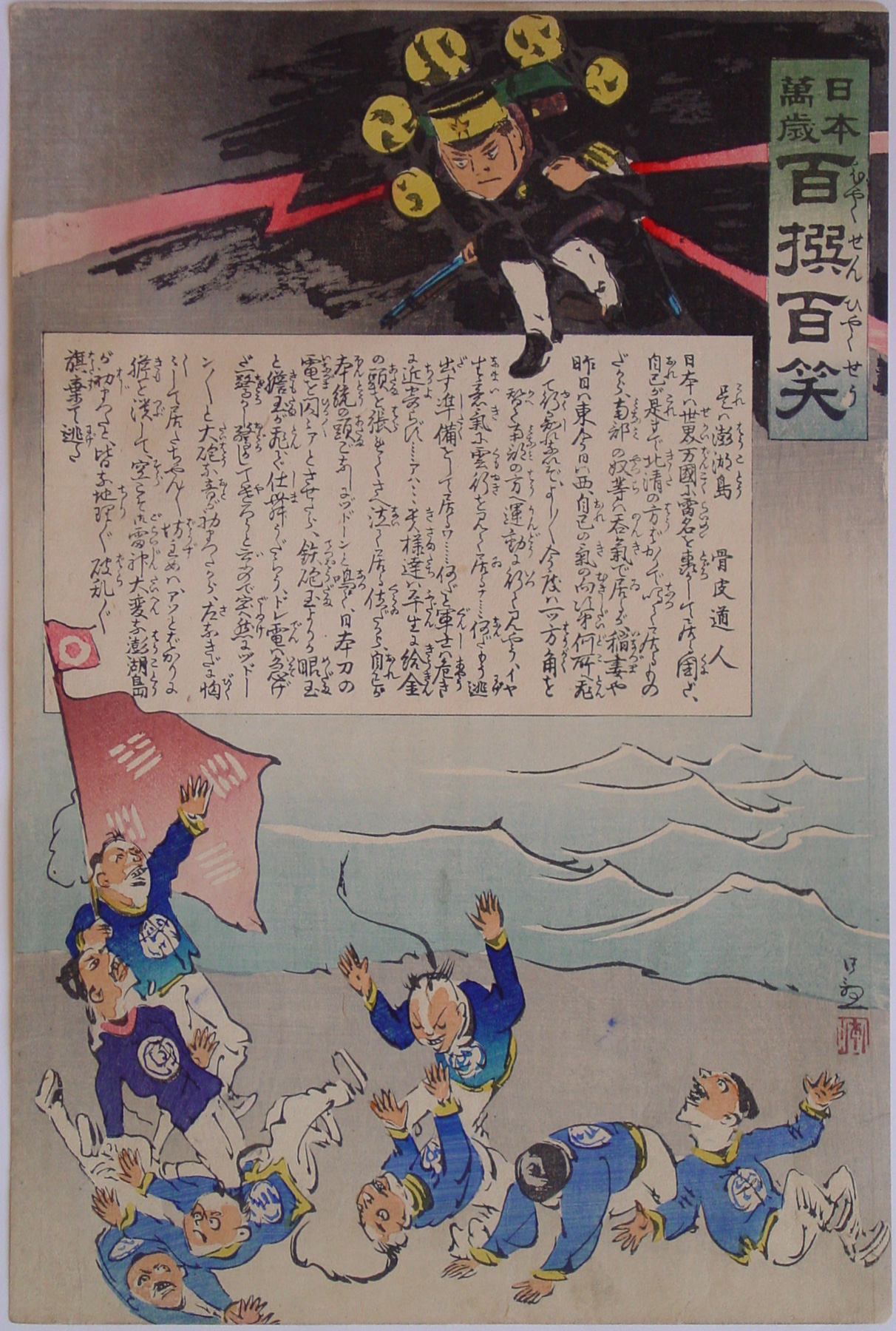About This Print
This print is one of fifty prints from the first part of the three part series One Hundred Victories, One Hundred Laughs. (Hyakusen hyakushô) created by the artist Kobayashi Kiyochika (1847-1915), the writer Nishimori Takeki (1861-1923), alias Koppi Dōjin, and the publisher Matsuki Heikichi (1870-1931).
In the print a Chinese troops fall to the ground in fear as a Japanese soldier in guise of the thunder god, with his drums and lightning flash appears.
About The Series One Hundred Victories, One Hundred Laughs
This series One Hundred Victories, One Hundred Laughs was issued in three parts and presented parodies of the enemy, the Chinese in the Sino-Japanese War of 1894-1895 and ten years later the Russians in the Russo-Japanese War of 1904-1905. The first part of the series titled Long Live Japan: One Hundred Victories, One Hundred Laughs, consisting of fifty prints, was issued between September 1894 and August 1895. The second part of the series titled Magic Lantern Society: One Hundred Victories, One Hundred Laughs, consisting of twelve prints, was issued between November 1895 and December 1896. Both of these parts parodied (often in a racist manner) the Chinese people, leadership and war effort. The third and last part of the series, consisting of eight-six prints, used the same title as the first part Long Live Japan: One Hundred Victories, One Hundred Laughs. Issued between April 1904 and April 1905, the prints parodied the Russian war effort. For more information about the series see the article One Hundred Victories, One Hundred Laughs on this site.
The Pescadores
日本ハ世界(せかい)万国(ばんこく)に雷名(らいめい)を轟(とどろ)かして居る国(くに)だ、 自己(おれ)が是(これ)まで北清(きた)の方(ほう)ばかりで鳴(なつ)て居るもの だから、南都(みなみ)の奴等(やつら)ハ呑気(のんき)で居(い)るが、稲妻(いなづま)や 昨日ハ東今日ハ西、自己(おれ)の気(き)の向(むき)次第(しだい)何所(どこ)へ飛(とん) で行(ゆく)か知(し)れないぞ、よしよし今度(こんど)ハ一ツ方角(はうがく)を 替(かへ)て南都(みなみ)の方(はう)へ運動(うんどう)に行(いつ)て見(やう)、イヤ 生意気(なまいき)に雲行(くもゆき)を見て居(い)るナ・・何(なん)だもう逃(にげ) 出(だ)す準備(したく)をして居るヮ・・何だと軍士(ぐんし)ハ危(あやう)き に近寄(ちかよ)らず・・アハハハハ貴様達(きさまたち)ハ平生(ふだん)に給金(きうきん) の頭(あたま)を張(はら)れてさへ泣(ない)て居る位(くらい)だから、自己(おれ)が 本統(ほんとう)の頭(あたま)ごなしにヅドーンと鳴(なつ)て、日本刀の 雷(いなづま)を閃(ぴかぴか)ァとさせたら、鉄砲玉(てつぱうだま)よりか眼玉(めだま) と膽玉(きもたま)が飛(とん)で仕舞(しま)うだろう、ドレ電(でん)ハ急(いそ)げ だ一驚(をどろ)かし驚(をどろ)かして遣(や)ろうと云(い)ふので突然(だしぬけ)にヅドー ンヅドーンと大砲(たいはう)な音(おと)が初まつたから、左(さ)なきだに恟(びく) 々(びく)として居たちやんちやん坊主(ばうず)めハ、アッとばかりに膽(きも)を潰(つぶ)して、空(そら)こそ御雷神(ごらいじん)大変(たいへん)な膨湖島(はうことう) が初(はじ)まつたと、皆な地理地理破乱破乱(ちりぢりばらばら) 旗(はた)棄(す)て逃(にげ)た
Nihon wa sekai bankoku ni raimei o todorokashite iru kuni da. / Ore ga kore made Kita no hō bakari de natteiru mono/dakara, Minami no yatsura wa nonki de iru ga Inazuma ya / kinō wa higashi kyō wa nishi, Ore no ki no mukishidai doko e ton/de yuku ka shirenai zo. Yoshi yoshi kondo wa hitotsu hōgaku o / kaete minami no hō e undō ni ittemiyō. Iya / namaiki ni kumoyuki o miteiru na…Nanda mō nige/dasu shitaku o shiteiru wa… Nan da to Gunshi ayauki / ni chikayorazu…ahahahaha kisama-tachi wa fudan ni kyūkin no atama o hararete sae naiteiru kurai dakara, ore ga / hontō no atamagonashi ni zudōn to natte, nihontō no / inazuma o pikapikā to sasetara, teppōdama yori ka medama / to kimottama ga tonde shimau darō. Dore den wa isoge da hitoodorokashi odorokashite yarō to iu node dashinuke ni zudō/n zudōn to taihō na oto ga hajimatta kara, sa naki dani biku/biku to shiteita Chanchan-bōzu me wa, a tto bakari ni kimo o tsubushite, sora koso go-raijin taihen na hōkotō / ga hajimatta to, minna chirijiri barabara / hata o sutete nigeta
Print Details
| IHL Catalog | #228 |
| Title or Description | These are the Pescadores (Penghu)! Kore wa Hōkotō 是ハ澎湖島 |
| Series | Long Live Japan: One Hundred Victories, One Hundred Laughs [also translated as Long Live Japan! One Hundred Selections, One Hundred Laughs] Nihon banzai: Hyakusen hyakushō 日本萬歳 百撰百笑 [日本万歳 百撰百笑] |
| Artist | Kobayashi Kiyochika (1847-1915) |
| Signature | Kiyochika |
| Seal | Kiyo |
| Publication Date | 1895 (Meiji 28) |
| Publisher | Matsuki Heikichi (松木平吉) proprietor of Daikokuya |
| Impression | excellent |
| Colors | excellent |
| Condition | good - light soiling throughout; margins trimmed; backed |
| Genre | ukiyo-e - senso-e (Sino-Japanese War); giga; fūshiga |
| Miscellaneous | |
| Format | vertical oban |
| H x W Paper | 13 7/8 x 9 1/8 in. (35.2 x 23.2 cm) |
| H x W Image | 13 7/8 x 9 1/8 in. (35.2 x 23.2 cm) |
| Literature | |
| Collections This Print | Östasiatiska musee OM-2010-0005; Princeton University Art Museum 2008-102.34 |


